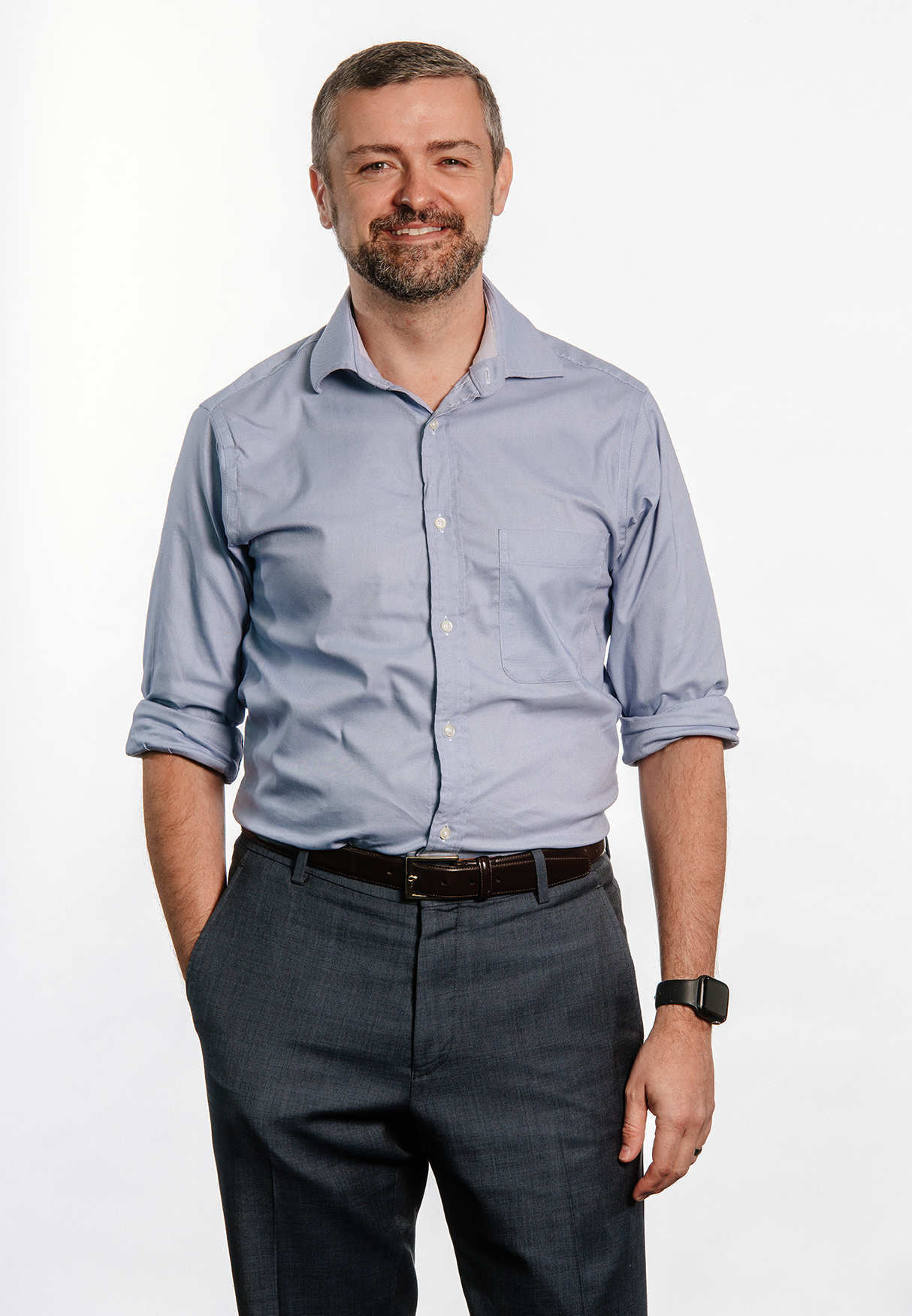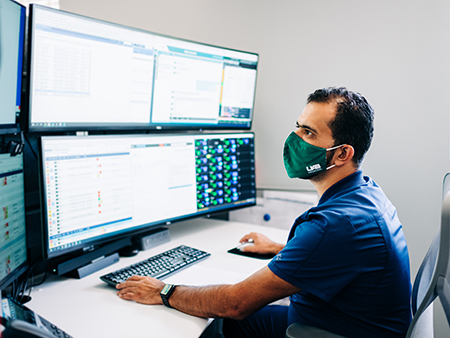Media contact: Anna Jones
Eric Wallace Eric Wallace, M.D., was recently selected as the 2021 Community Star of Alabama for his vast efforts in telehealth and innovation across the state of Alabama.
Eric Wallace, M.D., was recently selected as the 2021 Community Star of Alabama for his vast efforts in telehealth and innovation across the state of Alabama.
(Photography: Steve Wood), M.D., medical director of Telehealth at UAB Hospital and an associate professor in the University of Alabama at Birmingham Division of Nephrology, has been named the 2021 Community Star of Alabama by the National Organization of State Offices of Rural Health for his efforts in developing and providing access to health care opportunities through telehealth services for patients in rural communities.
This honor was announced on this year’s National Rural Health Day, an annual observance that emphasizes the importance of rural America and promotes the need for accessible, high-quality health care. National Rural Health Day falls on the third Thursday in November each year and recognizes the efforts of those serving the health needs of more than 60 million people across the nation. Wallace was selected for being a true champion of rural health care and for his many contributions in rural communities throughout the state.
Reshaping the landscape of rural care
Telehealth efforts across Alabama have greatly expanded in the past three years, reforming rural health care into a system that can provide both basic and subspecialty care to all Alabamians.
For decades, a great need has existed in Alabama to deliver critical care and subspecialty care in rural areas. Physician offices and hospitals in those areas have not had the financial resources or staffing bandwidth needed to provide specialty care.
Until recently, patients in need of nephrology, infectious disease, critical care or neurology services — among others — would be transferred to UAB, or another large urban hospital, to receive inpatient or outpatient care. The burden of such travel has been equally weighted on the hospital system and on the patient and their families.
Wallace identified these issues years ago, and in 2016, he became the first physician in the country to replace a comprehensive, in-person doctor/patient visit with a telehealth visit for home dialysis.
The successful first-of-its-kind appointment led to the creation of a secondary line of service, one that would create access to subspecialty care for thousands of Alabamians in rural areas.
Now, because of Wallace and his team’s telehealth efforts, along with several partnerships they have made along the way, the field of telehealth is headed in an innovative direction where the rural facility becomes a center capable of delivering subspecialized care so that specialty and emergency health care can be given to the patient within miles of their home.
Expanding efforts across the state
Because of UAB’s massive efforts in telehealth, Wallace and his team have been able to engage three other hospitals in tele-nephrology in Alabama to partner on helping patients from rural areas, and 14 other hospitals for telehealth.
As an example, a rural patient with kidney disease can access a subspecialty physician via tele-visit, where the specialist can look at their labs, charts and history. If the patient needs dialysis, then technicians in the area go to the hospital to provide dialysis. The process is similar for infectious disease and neurology patients, as well as critical care patients. If a patient needs to be intubated, the specialty doctor will assist with high-risk ventilator management to the on-site team.
Learn more about how Telehealth has been used during the COVID-19 pandemic here.
To care for one single patient, large units of health care providers, researchers, administrative teams and other health care staff are required to make telehealth options available.
“We’ve managed to put subspecialties into areas that had none,” Wallace said. “Building the relationships between doctors externally has been one of the most beneficial parts of our telehealth efforts. We can do a lot more together than we can do apart.”
This effort has required dozens of partnerships and networking, creating a telehealth system that asks teams from multiple institutions, organizations and hospitals to work together.
Removing barriers to provide equitable care
Wallace says telehealth lessens the seclusion of private practitioners in rural areas who may have limited resources. Plus, the telehealth model connects primary care physicians with subspecialists at UAB and other large hospitals to share knowledge. The subspecialists inform and apprise primary physicians of subspecialty diseases, new discoveries and therapeutics.
“Partnering with rural doctors can also increase the rate of dissemination of knowledge, bringing the cutting edge to everywhere faster,” Wallace said. “This faster pace of knowledge-sharing can quickly tear down barriers to accessing specialty care.”
In addition to the lack of resources for rural physicians, a major contributor to health disparities in the state is patient access to care. The amount of time, money and resources it takes to travel to and from large cities to receive care is a heavy burden. Wallace says, if patients can receive care in their own community, it could save lives, improve quality of life and raise the bar for health care across the state.
“We could turn Alabama into a model for equitable statewide health care,” Wallace said.
 UAB's tele-ICU helps support rural hospitals throughout the state.
UAB's tele-ICU helps support rural hospitals throughout the state.
(Photography: Andrea Mabry)Telehealth work has just begun
“This Community Star award represents the work of thousands of people,” Wallace said. “It shows how we can all work together. There are enough people and interest in Alabama and rural areas who care to make this work. Telehealth has been years in the making ... and is an attestation to Alabama’s goals. If we can make such giant strides in such little time, where will we be in another year and a half?”
Wallace sees telehealth already helping Alabamians and their physicians in a major way but knows there is so much more work to be done.
Celebrate National Rural Health Day
Join NOSORH and their event on National Rural Health Day to honor each 2021 Community Star in all 50 states virtually. This year’s theme is “The Power of Rural: Resiliency, Resolve, Relationships, and Readiness.” Over the past decade, National Rural Health Day has transformed from a one-day event to a sustainable movement that engages health care workers, policymakers, community partners and more. On Nov. 18 at 1 p.m. CST, the National Rural Health Day live event will introduce audiences to all 50 Community Stars, including Wallace. Join the interactive celebration here.